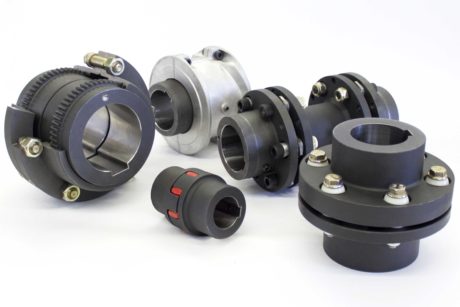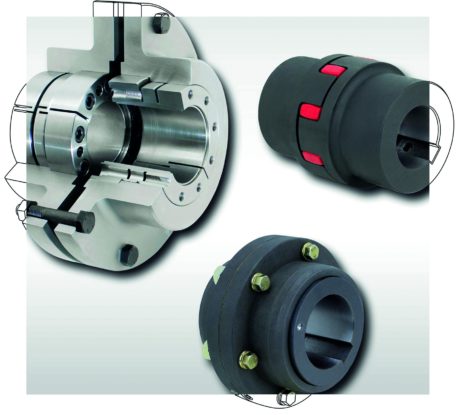
Ringspann is massively expanding its portfolio of non-shiftable shaft couplings.
The German company Ringspann has been working on the market with a large-scale product offensive in the field of shaft couplings. The admission of five completely new coupling types and the supplementation of numerous existing models amounts to a massive expansion of the overall range. The full-range supplier is thus providing engineers and product developers in industrial drive technology with even more options for the realisation of safe, powerful and installation space-optimised connections between shafts, motors, gearboxes and machines.

«This latest expansion of the product range is as yet unrivalled in the history of the company.»
Barely a month goes by without Ringspann being able to announce the implementation of the next stage of its development towards becoming a one-stop supplier for high-grade drive technology components. Just a few days ago, the company’s brakes and coupling division announced the massive expansion of its range of non-shiftable shaft couplings. It is important to realise that Ringspann has been devoted to the development and production of safety and starting clutches shiftable under load for more than 60 years. «However, this latest expansion of the product range is as yet unrivalled in the history of the company», stresses divisional manager Franz Eisele. While the focus of Ringspann’s portfolio in this field had been previously placed primarily on flange, flexible and cone clamping couplings, the overall selection is now being expanded thanks to the current product offensive with five completely new models. What that means: With immediate effect, you can now also find gear couplings, grid couplings, disc couplings and pin-and-bush couplings and jaw couplings ready to deliver. «This range now allows us to offer a total of eight models that cover almost all technically relevant types of rigid, torsionally stiff and elastic shaft couplings that are currently needed in industrial drive technology», says Franz Eisele.
Eight models up to 1,299,500 Nm
Across all eight models, the now available Ringspann spectrum of shaft couplings covers an astonishing range of nominal torques from 2.0 to 1,299,500 Nm! This also means that purchasers and engineers from every conceivable industrial sector and branch now have a comprehensive range of non-shiftable shaft couplings for applications in almost every area of drive technology available to them. Franz Eisele explains: «The beneficiaries of our comprehensive coupling range will not only be our current core target groups in conveyor technology, crane construction und gear manufacturing, but also many other plant manufacturers and mechanical engineers – for example those in fluid and process engineering, raw materials industry and steel production.»

New catalogue for download
A complete overview of Ringspann’s new portfolio of shaft couplings can be found in the freshly issued product catalogue 2018/2019, which is available for free download on the company’s website (www.ringspann.de). Here you find all coupling types and variants sorted according to design and area of application and described and depicted: The cone clamping couplings and tru-line flange-couplings for rigid connections; the gear, disc and flexible couplings for torsionally stiff connections; the grid couplings for initially elastic and later torsionally stiff connections; and the pin-and-bush and jaw couplings for elastic shaft connections. «We offer the suitable coupling for applications in which the torque is transferred torsionally stiffly without phase shift but the shaft displacements need to be compensated, just like for applications in which a defined torsional stiffness must be ensured through elastomers. The coupling connoisseurs amongst us may miss the highly elastic elastomer coupling model; but we will soon be putting that right», says divisional manager Franz Eisele.
And what the customer has come to expect with freewheels, brakes, shaft-hub-connections, overload clutches, clamping fixtures and push/pull cable systems of Ringspann naturally also applies for shaft couplings: Customer-specific modifications can always be realised beyond the standard version shown in the catalogue to adapt series clutches to unusual and special applications.
[su_box title=”A SHORT COUPLINGS ABC”]The main function of a shaft coupling is the connection of two shafts and the transmission of torques and rotational movements. Furthermore, shaft couplings are also required to fulfil a number of additional functions such as compensating shaft misalignment, dampening torque impulses and vibrations, protecting machines and drives against damages through overload etc. That is why many designs have emerged that can be differentiated in accordance with VDI 2240. One distinguishes primarily between shiftable (manual, speed-controlled, direction of rotation-controlled, torque-controlled) and non-shiftable shaft couplings. Since it is often not possible to cover all requirements with one design, you will often also find combinations of shiftable and non-shiftable couplings in industrial applications. The non-shiftable couplings are differentiated between:
Rigid couplings
The shafts are connected together rigidly by the coupling. Torques and rotational movements are directly transferred without a rotational angle offset. The couplings cannot, however, compensate any axial, radial or angular misalignment of the shafts. Accordingly, significant reaction forces can arise during operation for example due to inadequate alignment or thermal deformations that additionally stress the bearings of the drive train.
Torsionally stiff couplings
They act in the peripheral direction torsionally stiff, i.e. torques and rotational movements are transferred almost without rotational angle offset. Depending on the design, however, these couplings can compensate axial, radial or angular shaft misalignment.
Elastic couplings
These couplings are equipped with an elastic element that transfers the torque from the drive side of the coupling onto the output side. Elastic elements are commonly made of plastic or rubber. In special cases, elastic elements made of steel are also used. The elastic intermediate element leads to a torque-dependent rotational angle offset between the input and output side of the couplings. Furthermore, intermediate elements made of plastic dampen torque impulses and influence the resonance frequency of the drive train. Elastic couplings can also compensate axial, radial and angular shaft misalignment via the deformation of the intermediate elements.
Highly elastic couplings
These couplings are characterised by a high degree of torsional elasticity and large spring travel. This enables them to have a high damping capacity and can thus reduce rotational vibration and load impacts. By selecting a suitable elastomer, you can also influence the natural frequencies of the drive train in such a manner that they lie outside the operating speed range of the unit. This prevents resonance vibrations and limits torque peaks.[/su_box]



